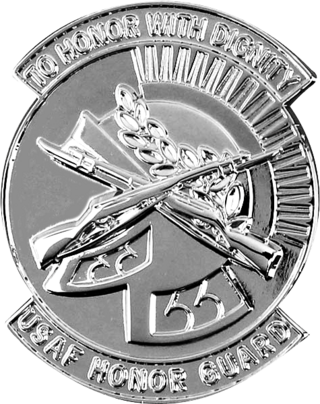
The Bronze Star Medal (BSM) is a United States Armed Forces decoration awarded to members of the United States Armed Forces for either heroic achievement, heroic service, meritorious achievement, or meritorious service in a combat zone.
The Combat Action Ribbon (CAR) is a United States Navy, United States Coast Guard, and United States Marine Corps military decoration awarded to United States sea service members "who have actively participated in ground or surface combat." Coast Guardsmen, Navy sailors, and Marines active in clandestine, stealth or special operations are deemed eligible for consideration of the award. The ribbon is awarded to members of the Navy and Marine Corps with a rank no higher than captain and colonel, respectively.
The United States Air Force officer rank insignia in use today.

The United States Astronaut Badge is a badge of the United States, awarded to military and civilian personnel who are employed with the National Aeronautics and Space Administration, who have performed a spaceflight. The military version is the least-awarded qualification badge of the United States armed forces.

A marksmanship ribbon is a United States Navy, Air Force, Space Force, and Coast Guard award that is issued to its members who pass a weapons qualification course and achieve an above-average score. Additionally, there are select state National Guard organizations that award marksmanship ribbons for high placement in state-level marksmanship competitions.

The Combat Readiness Medal is an award of the United States Air Force and United States Space Force created in 1964. The original Combat Readiness Medal was an award senior to the Air Force Commendation Medal, and it was awarded for superior and meritorious duty to the United States Air Force. The award criteria for the medal were revised in 1967 and the Combat Readiness Medal adopted the designation as a service medal.

The Air Assault Badge is awarded by the U.S. Army for successful completion of the Air Assault School. The course includes three phases of instruction involving U.S. Army rotary wing aircraft: combat air assault operations; rigging and slingloading operations; and rappelling from a helicopter.

The diver insignia are qualification badges of the uniformed services of the United States which are awarded to servicemen qualified as divers. Originally, the diver insignia was a cloth patch decoration worn by United States Navy divers in the upper-portion of the enlisted service uniform's left sleeve during the first part of World War II, when the rating insignia was worn on the right sleeve. When enlisted rating insignia were shifted to the left sleeve in late World War II, the patch shifted to the upper right sleeve. The diving patch was created during World War II, and became a breast insignia in the late 1960s.
The Observer Badge is a military badge of the United States armed forces dating from the First World War. The badge was issued to co-pilots, navigators, and flight support personnel who had received a variation in the training required for the standard Pilot's Badge. The Observer Badge survived through the Second World War and into the 1950s, at which time the concept of an Observer Badge was phased out in favor of the modern Aircrew Badge and Navigator-Observer Badges. In addition to wings for Naval Aviators and Naval Flight Officers, the United States Navy still maintains an "Observer Badge" which is issued to flight-qualified mission specialists, such as a select number of meteorologists and intelligence officers in both the U.S. Navy and U.S. Marine Corps. The U.S. Air Force awards its USAF Observer Badge, which is identical to the USAF Navigator Badge, to Air Force officers who have qualified as NASA Space Shuttle Mission Specialists, have flown an actual mission aboard the shuttle and/or the International Space Station and who are otherwise not previously aeronautically rated as an Air Force pilot or navigator.
The Missile Badge is a military decoration of the United States Air Force which was first created on 23 May 1958. The "pocket rocket" badge recognizes those commissioned officers and enlisted personnel of the US Air Force who have qualified as missile personnel that have been trained in the maintenance or launching of land-based and air-launched nuclear weapons under the direction of the National Command Authority. Originally known as the Missileman Badge, the Missile Badge later became known as the Missileer Badge or more informally the Pocket Rocket and is still often referred to by this name.

The Parachutist Badge, also commonly referred to as "Jump Wings", is a military badge of the United States Armed Forces. Some services, such as the Marine Corps, officially refer to it as an insignia instead of a badge. The United States Space Force and United States Coast Guard are the only branches that do not award the Parachutist Badge, but their members are authorized to receive the Parachutist Badges of other services in accordance with their prescribed requirements. The DoD military services are all awarded the same Military Parachutist Badge. The U.S. Army and U.S. Air Force issue the same Senior and Master Parachutist Badges while the U.S. Navy and U.S. Marine Corps issue the Navy and Marine Corps Parachutist Insignia to advanced parachutists. The majority of the services earn their Military Parachutist Badge through the U.S. Army Airborne School.

Insignias and badges of the United States Navy are military badges issued by the United States Department of the Navy to naval service members who achieve certain qualifications and accomplishments while serving on both active and reserve duty in the United States Navy. Most naval aviation insignia are also permitted for wear on uniforms of the United States Marine Corps.

Badges of the United States Air Force are specific uniform insignia authorized by the United States Air Force that signify aeronautical ratings, special skills, career field qualifications, and serve as identification devices for personnel occupying certain assignments.

The United States Air Force Honor Guard Badge is a military badge of the United States Air Force that is authorized for wear by all personnel who are assigned to the United States Air Force Honor Guard, or to active members of a Base Honor Guard (BHG). For males, the badge is worn as a decoration centered on the left uniform pocket, below standard awards and decorations. For females, it is worn on the right side, even with the bottom of their decorations.

The Combat Action Badge (CAB) is a United States military award given to soldiers of the U.S. Army of any rank and who are not members of an infantry, special forces, or medical MOS, for being "present and actively engaging or being engaged by the enemy and performing satisfactorily in accordance with prescribed rules of engagement" at any point in time after 18 September 2001.
The Aircrew Badge, commonly known as Wings, is a qualification badge of the United States military that is awarded by all five branches of armed services to personnel who serve as aircrew members on board military aircraft. The badge is intended to recognize the training and qualifications required by aircrew of military aircraft. In order to qualify as an aircrew member and receive the Aircrew Badge, such personnel typically undergo advanced training in aircraft in-flight support roles.

A colonel in the United States Army, Marine Corps, Air Force and Space Force, is the most senior field-grade military officer rank, immediately above the rank of lieutenant colonel and just below the rank of brigadier general. Colonel is equivalent to the naval rank of captain in the other uniformed services. By law, an officer previously required at least 22 years of cumulative service and a minimum of three years as a lieutenant colonel before being promoted to colonel. With the signing of the National Defense Authorization Act of 2019, military services now have the authorization to directly commission new officers up to the rank of colonel. The pay grade for colonel is O-6.

The Airman Battle Uniform (ABU) is a U.S. camouflage combat uniform formerly worn by members of the United States Air Force, United States Space Force, and some civilian employees of the U.S. Department of the Air Force until April 2021. It replaced the Battle Dress Uniform and Desert Camouflage Uniform on 1 November 2011 after a four-year phase-in period.

The uniforms of the United States Air Force are the standardized military uniforms worn by members of the United States Air Force to distinguish themselves from the other services.

Badges of the United States Space Force are specific uniform paraphernalia authorized by the United States Space Force that signify ratings, special skills, career field qualifications, and serve as identification devices for personnel occupying certain assignments. Space Force occupational badges are awarded in three degrees or skill levels. Badges for space operations are awarded at basic, senior, and command levels; other occupational badges are issued in basic, senior, and master level. A star and wreath system, worn above the badge, denotes which degree or skill level a service member currently holds.














